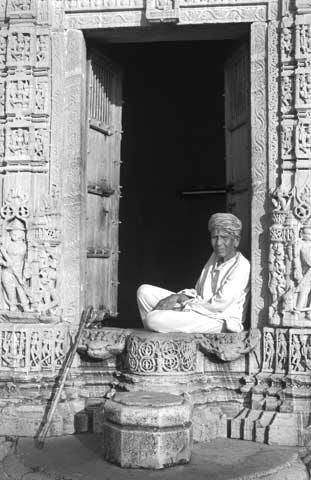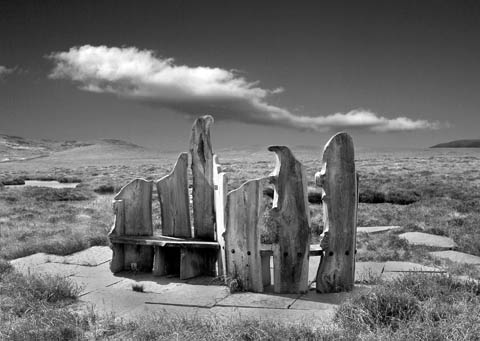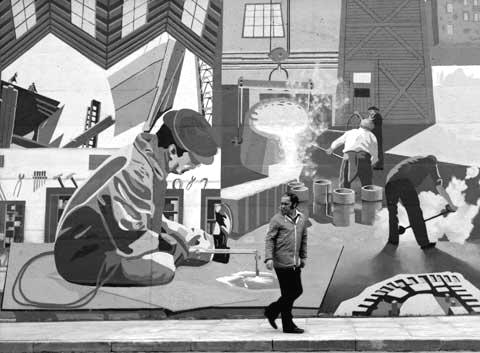
MONOCHROME TRAVEL PHOTOGRAPHY
“Travel photographs allow us to relive our experiences”, that’s one good reason for taking them. I will never forget the moment when, for the first time, I saw one of my transparencies projected onto a screen. The saturated colours and sense of the third dimension were stunning; it was as if I was back at that time and place. I was hooked.
A little later I discovered the magical world of monochrome photography. Although colour is usually the first choice of the travel photographer there are occasions when black & white is a more powerful medium in which to capture subjects.
Some photographers, in the past, considered colour to be a distraction & monochrome to have the ability to capture the core of the theme without the complications that can arise with colour.
The Photographic Society of America has made things easy by clearly defining what constitutes a photo travel picture: -
“A Photo Travel picture is one that captures the feeling of the time and place, portrays a land, its people, or a culture in its natural state, and has no geographical limitations.” Ultra close ups which loose their identity, studio model shots and heavily manipulated images are unacceptable for international exhibitions.

At Father's Knee
Forward planning is very important and successful travel photographers invariably research the area they are visiting. An itinerary is essential to gain the maximum from photographic opportunities that may exist. A list of places to visit and things to see can make a big difference to the results achieved.
I never travel anywhere without two vitally important accessories, one is a compass and the other a beanbag. A compass is useful in working out when the light will be best for a subject. Tripods are difficult to transport and on many occasions too slow to use, this is where a beanbag can prove very useful. A canvas bag measuring 7x7 inches and sealed on one side with Velcro can be filled with beans or rice purchased locally. This will provide excellent stability especially when shooting from a vehicle or viewing platform on safari.
With increased security at airports and the emphasis on weight restrictions for hand luggage it is best to limit your equipment to a minimum. My minimum is two camera bodies, one for B/W and one for colour slide. Three lenses, 17mm, 28-200mm, 90mm macro, a flashgun and monopod. I avoid putting anything fragile in the main luggage; some baggage handlers enjoy a pastime of seeing how high a case will bounce when thrown to the ground. Lenses are quite delicate and can suffer catastrophic results from impact damage. Filters are OK for the main luggage but a monopod looks too much like a weapon and will attract further inspection along with broken locks and damaged cases.
“Get off the beaten track” would be my advice to anyone wanting photographs with a difference. This could entail something as simple as exploring side streets or back lanes in a town to hiring transport and visiting small villages in remote country areas.

Temple Guardian
The curse of photography in most foreign parts is a high sun that results in high contrast. Early and late light is usually best so early rising is a must in order to capture the best results. That said I am a great believer in taking what you can when you can and maximising the potential of the subject. This can be at the taking stage or later when printing.
My favourite filter for monochrome is yellow, which replaces my skylight filter as a lens protector & provides basic monochrome correction. It lightens sand & stonework & darkens blue skies helping to emphasise clouds. Other invaluable filters are green, a much underused filter, that will lighten green foliage & fields & orange which is similar to yellow but gives more dramatic results. Another one worth considering is the polarisering filter. It will eliminate glare & produce very dramatic skyscapes under the right lighting conditions.

Doris Sheehan's Monument
The secret of good monochrome photography is to try to ignore the seduction of colour. Think & see in terms of light & shade, look for pattern form & texture & aim to capture them in shades of grey. Digital cameras have made things even more exciting. We can now convert colour images at a stroke to monochrome; however it is still very important to “wear a black & white hat” & see & think in terms of monochrome at the taking stage.
What makes a good travel photographic subject? Landscapes, buildings, people, cityscapes. Virtually anything that can be covered by the definition of travel photography. It is thought the best travel photographs results are achieved when a “fly on the wall” documentary approach is employed. In an ideal world this is probably true; however it is very important to take lots of photographs at every opportunity. You may not get a second chance.

Industrial Tyneside
One parting thought, it is said that familiarity breeds contempt. Photographers being too familiar with their surroundings have missed many golden photographic opportunities, sometimes never to be repeated. So when travelling it is important to take lots of pictures when a place is still new to you. It may not be long before you consider it commonplace.